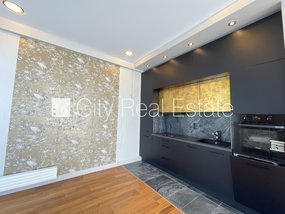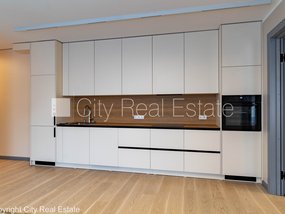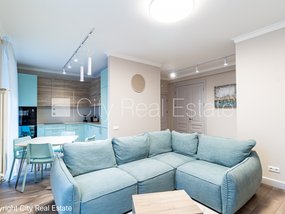
Construction of buildings of this series was started in early 1970s but the last projects of this type were implemented as late as in 1990s.

104 series apartments have functional and comfortable layout – next to bedroom there is toilet facilities, and next to guestroom is kitchen.

This is one of the most sought-after series of flats, equal in price to flats of the 103 and 104 series, which are the most sought-after lodging series on the realty market.

Contrary to other panel houses, external walls of the 9 storey buildings in the 467 Series may be decorated with coloured tiles or plastered with broken stone.

Buildings of the 602 Series are large-sized panel buildings with nine storeys (there are also buildings with 6 storeys), with their load-bearing structures formed of wall panels made from claydite concrete and reinforced concrete floor slabs.

Czech Project has atypical apartaments, mostly in all apartaments is loggia and quite spacios kitchen.

Buildings of this Project are 16 to 18 storeys high and have built-in garbage bin and two elevators. All apartaments have loggias.

Walls are built using silicate bricks for older buildings, panel blocks were later used instead. There are buildings with balconies and ones without balconies. The flats are small, with communicating rooms. Isolated rooms are rare.

Buildings of Small Family project are built from blocks. Mostly all buildings of this project are 5 and 9 floor high, but also there is 12 floor building made of bricks.

The Lithuanian project is characterised by large-sized panel buildings with five storeys with partition walls made from gypsum concrete. Buildings of Old Lithuanian project have balconies.

The Lithuanian project is characterised by large-sized panel buildings with five storeys with partition walls made from gypsum concrete. New lithuanian project buildings of this design have loggias.

The height of these buildings varies from 2 to 6 storeys, built form bricks, outer walls are daub plastered and coloured.

Details in dimensions and facades were typical for this time and are found around the regularly arranged windows, in gables and cornices.

Stone buildings in Latvia came along with colonizers and western christianity bearers in end of 12th century and till begining of the 13th century.

Buildings are 5 storeys. Each apartment have either balcony, or loggia. Walls are built using silicate bricks for older buildings, panel blocks were later used instead.

Specprojects are called buildings which mismatch to any of standard project buildings - neither with building and apartaments planning, nor with materials used for its building.
Roots of multi-storey dwelling house regions are searched in the beginning of the century. The principle of the mutual partition of dwelling and other functional areas established by functionalism in the 20th years became as a basis for the development of dwelling regions of the second half of the 20th century in many places in the World, also in Riga. It meant that big construction territories were made the onliest function of which was in living. Unlike from a plastic detalization of facades characteristic formerly, solaring of premises became a main determinator in the development of architectonic character. As a result of it, the widely glazed multi-storey kind of box volume came into being.
The dominant type of mass construction of the 50th years was five-storey buildings of silicate bricks with low-pitched four slope or two slope roofs, without balconies, or any other plastic of facades, and with a very compact, even compressly made design of apartments. A construction of big panel dwelling houses in Riga started in the beginning of 60th years. Statistical data show that, since the 60th years, the city experienced a construction boom of apartments, still unprecedent, that, however, all time, was at the competition state with a constantly increasing number of inhabitants of city. Dwelling regions of big panel buildings are made in a bow around the historical center of the city in both sides of Daugava, mostly in formerly vacant territories, or in former construction regions with a small number of storeys. Brick and mixed type multi-storey buildings are met near the center of city, in a very center – buildings of architectonically qualitative individual projects prevail.
Dwelling region of Agenskalns Pines (1958-1962) was established as the first territory with a construction of panel houses: one part of the region was built with silicate brick buildings, but the second – with big panel buildings of the same form and design structure. The region was provided for 25 thousand inhabitants. Next, Jugla with 35 000 inhabitants and Kengarags with already 60 000 inhabitants followed. Years 1965-1975 is the period of the most intensive construction when Kengarags, Imanta (60 000 inhabitants in each), Purvciems (65 000 inhabitants), as well as Bolderaja (15 000 inhabitants) were built. Ilguciems (37 000 inhabitants) and Vecmilgravis (39 000 inhabitants, although a bit later, in 1968-1980) followed. During 1977-1985 years, a dwelling region of Mezciems was built for 20 000 inhabitants, but the 80th years came with a last great construction wave of big panel buildings: in the year 1985, Plavnieki for 60 000 inhabitants and Zolitude for 25 000 inhabitants were built. In the beginning of the 90th years, Ziepniekkalns for 22 000 inhabitants was made.
Objects of trade, consumer services and public character are placed in the central part of regions. A secondary education establishment, as well as kindergartens are placed in every microregion that, on the whole, conform to functionalism theories of the first part of the century. Practically, there are not public objects and spending free time or entertainment objects in them. In a wider point of view, these dwelling regions are deemed as sleeping regions of the city.
The link of dwelling regions with the center of city and other parts of city is provided by public transportation of the city: a tram, troleybus, bus and microbus. Traffic of public transportation is mostly effective, however, time capacious: separate parts of the city are situated even in the distance of more than one hour drive from the center, and a persistently increasing number of light vehicles in streets of Riga causes substantial traffic jams that bother a movement of public transportation.
One of basic principles of functionalism of city construction was as wide as possible development of the green area in a dwelling region around high and at a distance placed dwelling houses. In Riga, in a diverse event, this principle has reached its contrast: dwelling houses are mainly included by wide grasslands between asphalted straight angle pavements and drives. Today, on the account of green area, parking lots form spontaneously in microregions – both free of charge, and paid. Cars are placed along sides of all drives. The most part of streets and drives are in a very critical technical condition, burdening the functionation of already existing infrastructure, and in addition decreasing the quality of life in multi-storey dwelling regions.
In the beginning of the 60th years, the principle of free design of dwelling regions was popular. It meant that buildings were placed independently of the net of streets and according to meridional orientation to provide a maximum solaring of premises. In line with these principles, the multi-storey construction of dwelling regions of Agenskalns Pines, as well as Liela Jugla is made. In later dwelling regions, the organization around partly closed inner yards, placing buildings mutually both in straight, and wide angle, for example, in dwelling region of Kengarags and Imanta, became as one of main principles. Buildings are placed in different racourses that reduce a little the uniformity of the character of environment. A placement of buildings, making structures of full or incomplete hexagons, is used in the design of Purvciems dwelling region. More plastic and multiform design structures appear in Mezciems and Plavnieki regions.
Buildings are made in kind of box forms, they differ by height, length (in a line with a number of sections), tone – white or light grey, their plastic is enriched by balconies moved out, or by loggias directed inside. Usually, for the construction of one region, 2-3 standard projects are used, that differ mutually with a number of floors and detailed elaboration of elements, as well as with nuances of design of apartments. The dominant height of buildings in regions of 60-70th years is 5 floors, that is a maximal number of floors in a building, in order according to construction provisons of that time, the development of lift would not be necessaray in them. The highest buildings of 9 or 12 storeys appear somewhere as city structuring accents. In the beginning of 80th years, nine-storey buildings become as a dominant of the construction in dwelling regions (then acknowledged as the most economic in a group of those buildings where the development of lift is necessary), at the end of 80th years - buildings of 10 and 12 storeys.
Series 464 appeared as the first in Riga, also known as a Lithuanian project, (widely used in a construction of Kengarags and Imanta dwelling regions). Buildings have 5 floors, they are made of grey concrete panels in which window apertures are made. Visually fragile balconies in the South side supplement a detalization of facade plane, but in later solutions - loggias. The characteristics of series 464 (the Lithuanian project) is leafy, however, not very cultivated greeneries – bushes, trees, vines on facades that have formed during 30 years of existance of construction.
Series 467 series came in the construction of Riga as the next –light grey big panel buildings of 9 floors that are widely met in Kengarags, Purvciems and elsewhere. The composition of facades is determined by vertical zones of loggias that are actively glassed-in today. Dull colors in painting of outer walls of parade stairs, lighter tones - in rails of loggias. Small variations appear in the development of staircase windows, where the split rythm followed by staircases appear. Drying sheds are built on roofs that earlier enriched the silhouette, however, today are not used for a provided function, and create a sence of desolation with its blind frame.
A spatial character of Imanta, as well as Purvciems dwelling regions mainly is determined by construction of series 602 buildings. They are 9 storey white boxes which light color is determined by panels finished with a fine white tilling. Balconies are usually situated outside a facade plane. Big grass covers without the determined function dominate in yards, untidy and untended greenery made by bushes and undergrown trees.
The project of 119 series is developed in Latvia on the site that is widely met in Purvciems, Ziepniekkalns, Zolitude, Plavnieki. A construction has 9 storeys (sometimes 6 and 10 storeys), in places, glazed tiles are used to finish outer panels. Buildings are irregularry inclined each against other and interconnected, making groups of buildings where it is hard to orietate oneself. The parallelepiped form is kept in volumes, but the rythm of facades is made by vertical zones of facades.
Littel by little, Riga is reached by whiffs of new forms and detailed searching of ideas based in postmodernism. Series 602 (improved) that is met the most widely in Plavnieki, as well as in Dreilini, in a certain amount is the result of this trend. Buildings have 9 storeys, the kind of box form with seizing of loggias is kept, however, combinations of colors and compositions of facades are new. A unified range of colors is used in a painting in a framework of each group of buildings, a difference appears in a division of color areas, a geometrical composition is kept. The highest buildings - 16 storeys (later also 12) – are houses of series 104. In conditions of Riga, they can be called as type of point houses. A comparatively small prevalence of buildings in the city allows to perceive them as successful enough elements diversifying environment. A combination of painting is prevailingly made by grey concrete and brown balconies, however, also other combinations are met somewhere. Also wide loggias of these buildings are glassed in today .
A narrowness and unsatisfactory functional links between premises, as well as not too wide range of premises are characteristic for apartments of panel buildings of Riga. Narrow corridors and sanitary nets, of minimal dimensions, kitchens where it is not possible to sit and eat, narrow and long rooms, where the placement of furniture cannot be varied, - these are main deficiencies of the design of apartments. For separate series of houses balconies are only for several apartments, in addition, they, of course, have less private space than in loggias, in which there is a space closed from three sides. A negative trait is also a low ceiling of premises. Later ones are made more comfortably, projects worked out here in Riga or adopted from Lithuana, or abroad (mainaly, a construction of small panels), however, undesirable compression is also met in them together with an unnecessary spatial dissipation.
The uniformity of height of buildings is dispiriting, big empty areas between them and a general unspurcedness of environment both from the technical point of view, and flat roofs of buildings non-conforming to climatic conditions and in a bad condition: their trickling subjugate to the risk all building. Filling of seams of panels between facades is unsatisfactory that is imperfect and crumbles as a result of influence of atmosphere, therefore subordinating connections of construction to the influence of atmosphere that reduces rigidity and safety of the construction, especially, at connnection places of metal elements of panels. Heat resistance of outer walls of buildings is not satisfactory, too. Losses of heat are characteristic for big panel buildings through joint seams of panels and panel themselves, however, the biggest losses of heat happen through windows of buildings (in which there are only two glasses). Also engineering technical nets of buildings are weared out.
Literature used for preparation of information: <link www.lv.wikipedia.org/>www.lv.wikipedia.org</link>, an article „Multi-storey Dwelling Houses in Riga”.
The publication of data without a reference and written agreement of LTD „City Real Estate” is prohibited!

Apartment for rent in Riga, Riga center
Stabu street, 1th floor, 3 rooms, 105.70m2
1800.00 EUR 17.03 EUR / m2

Apartment for rent in Riga, Riga center
Krisjana Barona street, 2th floor, 2 rooms, 55.20m2
830.00 EUR 15.04 EUR / m2

Apartment for rent in Riga, Riga center
Antonijas street, 4th floor, 2 rooms, 57.00m2
900.00 EUR 15.79 EUR / m2